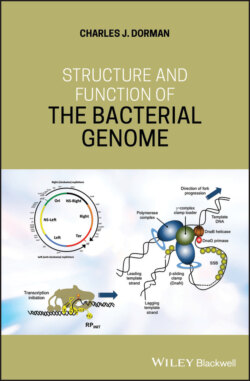Читать книгу Structure and Function of the Bacterial Genome - Charles J. Dorman - Страница 58
1.47 Hha‐like Proteins
ОглавлениеH‐NST's close similarity to the oligomerisation domain of H‐NS and its ability to form heteromeric complexes with H‐NS is superficially similar to the relationship of H‐NS to the Hha family of proteins. Found only in the Enterobacteriaceae, these too mimic the oligomerisation domain of H‐NS in their structure but unlike H‐NST, their interaction does not interfere with H‐NS‐mediated transcription silencing. Instead it channels the negative influence of H‐NS to certain target promoters (Baños et al. 2009; Madrid et al. 2007).
Y. enterocolitica possesses just one housekeeping Hha‐like protein (called Hha), in contrast to other model organisms like E. coli and Salmonella that have both Hha and a closely related paralogue, YdgT. However, pathogenic strains of Yersinia express YmoA (Yersinia modulator) from a chromosomal locus. YmoA is a founding member of the Hha protein family that regulates virulence genes negatively in Yersinia spp. (Cornelis et al. 1991; de la Cruz et al. 1992). It does this by forming a complex with H‐NS in which H‐NS provides the DNA‐binding activity (Ellison and Miller 2006b). YmoA potentiates the transcription repression activity of H‐NS, targeting virulence gene promoters in Yersinia (Ellison and Miller 2006b). It shares this property with Hha itself and with the Hha paralogue YdgT (Nieto et al. 2002; Starke and Fuchs 2014). YdgT is a paralogue of Hha and shares with Hha an ability to form heteromeric complexes with H‐NS and StpA (Paytubi et al. 2004).
YmoA is structurally closely related to Hha, it mimics the oligomerisation domain of H‐NS (McFeeters et al. 2007), and it is turned over by Lon‐ and ClpXP‐mediated proteolysis (Jackson et al. 2004). YmoA and Hha each interact with an H‐NS dimer, stabilising the transcription‐silencing complex at target promoters (Cordeiro et al. 2015).
In the case of Salmonella, Hha‐like proteins target H‐NS to the major virulence genes in the SPI1 and SPI2 pathogenicity islands and on the Salmonella virulence plasmid, pSLT (Silphaduang et al. 2007; Vivero et al. 2008). They can also influence the DNA‐binding mode of H‐NS and whether this protein forms polymers along DNA or creates bridges between different segments of DNA (van der Valk et al. 2017). Hha and YdgT direct H‐NS towards horizontally acquired genes, causing them to be silenced preferentially (Aznar et al. 2013). In E. coli, Hha/YdgT also targets horizontally acquired genes via H‐NS/StpA binding, together with genes involved in the osmotic and carbon starvation stress responses (Ueda et al. 2013). Genes encoding Hha‐like proteins also occur on self‐transmissible plasmids and their products can interact with H‐NS. For example, the virulence plasmid in the pathogenic E. coli strain O157:H7 encodes a form of Hha that directs H‐NS to just a subset of the targets that are bound by H‐NS when in a complex with the chromosomally encoded Hha protein (Paytubi et al. 2013). Plasmid‐encoded H‐NS proteins, such as the one expressed by the R27 self‐transmissible plasmid in Salmonella, target genes of HGT origin in the chromosome, a task that requires the Hha helper protein when it is performed by the chromosomally encoded H‐NS protein (Baños et al. 2009).
